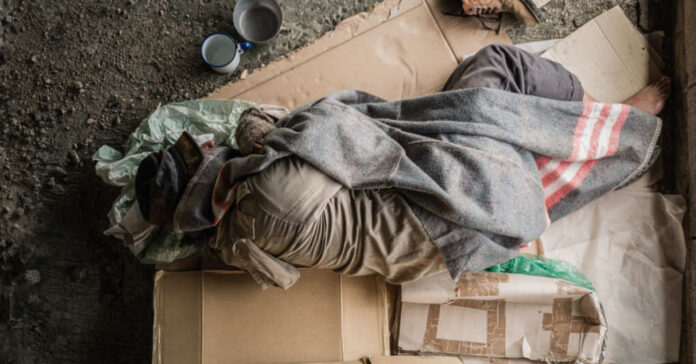
There is bad news for the homeless in San Diego. It’s time to move on and be homeless elsewhere. On June 13, the Unsafe Camping Ordinance, created to address the alarming rise of homeless encampments around public spaces, will be brought before the city council for a vote.
The hearing comes after the San Diego Regional Task Force on Homelessness found a 32% increase in the number of homeless people living on the street or an estimated 3300 homeless persons. 2100 of the affected people are staying in vehicles and sidewalks in downtown neighborhoods while many settle into temporary encampments wherever they can find space.
Unfortunately for residents of San Diego, that space includes parks and other public thoroughfares.
Mayor Todd Gloria remarked, “Park users and park employees regularly encounter makeshift camps with piles of garbage, damaged or destroyed restrooms, discarded hypodermic needles, feces and urine, and other hazards created by people who should not be living in or near our parks,” adding, “And we cannot help the people who are living in these encampments if they continue to say ‘no’ to services.”
“It’s a lie to represent people as service resistant when hundreds of people every week can’t get into shelter because we don’t have beds,” responded homeless advocate John Brady. Currently, only about 87% of San Diego’s 3,000 emergency shelter beds are being used.
But Gloria disagrees. “This is a long-term commitment by this city to provide resources for vulnerable and sick individuals to give them a better place to go than the sidewalk,” Gloria said. “Our expectation is when those resources are available, they must take them.”
The highlights of the Unsafe Camping Ordinance include prohibiting tent encampments in all public spaces throughout the city if shelter beds are available and banning all tent encampments in certain sensitive areas, such as in parks, near schools and transit stations, and, perplexingly, near homeless shelters.
“This is a long-term commitment by this city to provide resources for vulnerable and sick individuals to give them a better place to go than the sidewalk,” Gloria said. “Our expectation is when those resources are available, they must take them.”
The highlights of the Unsafe Camping Ordinance include prohibiting tent encampments in all public spaces throughout the city if shelter beds are available and banning all tent encampments in certain sensitive areas, such as in parks, near schools and transit stations, and, perplexingly, near homeless shelters.
Ever compassionate, Gloria pointed out during a press conference in Balboa Park, “They (residents) expect to be able to walk on sidewalks unobstructed, they expect to be able to get their children to school safely, they expect to be able to use our parks in a hygienic and clean and safe way. This park, like all our parks, is not a homeless shelter. It’s not a place to live, it’s not a giant toilet, it is not a trash dump.”
According to Gloria, the Unsafe Camping Ordinance will not immediately disband the encampments, and there will be different applications for neighborhoods across the city. There was a past settlement with the city that permitted the homeless to be on the sidewalks between 9 pm and 5:30 am, an agreement that Gloria will be forced to honor.
Those opposing the UCA claim that it is “heartless” and ineffective and raise questions about how existing shelters can handle the expected surge when they have limited resources. Supporters say the proposal was drafted “with compassion” because its goal is to help the homeless access shelters while protecting them from the dangers of the streets.
San Diego is the most recent city on a growing list, hoping to mask the homeless problem by prohibiting encampments. Last week, the Portland city council passed its own ordinance banning homeless encampments during the day. The homeless of Portland can camp in approved spaces from 8 pm to 8 am but must take down their sites between 8 am and 8 pm.
For San Diego, the drive to hide the homeless problem is more than compassion. Homeless encampments have the potential to hit San Diego in the wallet. The city was recently announced as the third-best destination for business tourism and maintains its spot as a favorite vacation locale. “We’re the number two industry here in San Diego. There’s a lot that rides on visitors that come to San Diego,” said Julie Coker, The San Diego Tourism Authority President and CEO. “Last year, we welcomed 28.8 million visitors to our destination, and they spent over $13 billion in our destination.”
Homeless encampments can be found in many of the top tourist spots throughout San Diego, including Balboa Park and several landmark canyons like Tecolote Canyon Natural Park and Nature Center.
The homeless are far more likely to commit crimes. San Diego compiled statistics that revealed homeless persons were 175 times more likely to commit burglary, 130 times more likely to commit assault, and 514 times more likely to commit arson. In addition, the homeless are more likely to be victims of crimes.
The San Diego DA’s office noted that those experiencing homelessness are involved with crime “at dramatically higher rates than the rest of the population,” both as victims and offenders. Additionally, Recidivism rates were also high for homeless persons. 83% of defendants had two to four new cases filed against them by local prosecutors, and 15% had five to nine new cases filed between 2019 and 2021.
San Diego’s solution? Ban homelessness and move affected citizens along to be someone else’s problem.
But the homeless in San Diego aren’t taking the proposal laying down. Rachel Hayes, homeless for ten years, predicts, “If they do the encampment ban, we’re just going to move to your neighborhood.”











